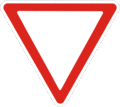Road signs in Ukraine
Road signs in Ukraine are governed by a combination of standards set out by the Vienna Convention on Road Signs and Signals, the European Union, and the Ukraine Transport and Roads Agency. The first need for a national standard for roads and road signage became apparent after the collapse of the USSR and the emergence of Ukraine as an independent country. Signs are set out in 7 separate categories based on meaning; Warning, Priority, Prohibitory, Mandatory, Information, Guide, and Additional Plates.[1]
Ukraine drives on the right as with the rest of Europe, except for Cyprus, Ireland, Malta and the United Kingdom.
Warning
Warning signs are an upward-pointing red triangle, with white backgrounds and black pictograms. Yellow backgrounds are used for temporary dangers or roadworks conditions. Signs may include additional plates detailing the danger, who the signs apply to, or other necessary information.
-
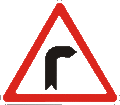
Curve to the right
-
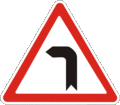
Curve to the left
-

Series of curves, first to the right
-

Series of curves, first to the left
-

Sharp deviation to right marker
-

Sharp deviation to left marker
-

Abrupt end of road marker
-
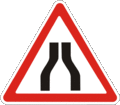
Road narrows on both sides
-

Road narrows on the right
-

Road narrows on the left
-

Upwards slope (with grade percentage)
-

Downwards slope (with grade percentage)
-

Unprotected riverbank or quayside near road
-
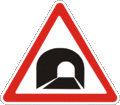
Tunnel
-

Uneven road surface
-

Bump
-

Dip
-

Slippery road surface
-
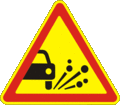
Loose road surface
-
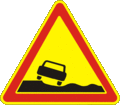
Uneven road shoulder
-
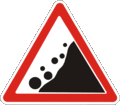
Danger of falling rocks
-

Powerful crosswinds area
-

Low-flying aircraft
-
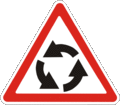
Roundabout ahead
-
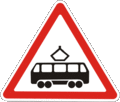
Tram crossing
-

Crossroad ahead with priority to the right
-

Crossroads ahead with a minor road
-

Minor road ahead on right
-
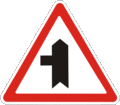
Minor road ahead on left
-

Staggered crossroads ahead with first on right
-
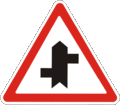
Staggered crossroads ahead with first on left
-
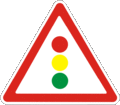
Traffic signals ahead
-

Draw bridge ahead
-
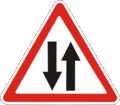
Two-way traffic ahead
-
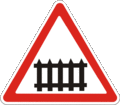
Railway crossing ahead with gates or barriers
-

Railway crossing ahead without gates or barriers
-

Railway crossbuck (one track)
-

Railway crossbuck (multiple tracks)
-

Countdown beacon to railway crossing on right side of road (300 metres to crossing)
-

Countdown beacon to railway crossing on right side of road (160 metres to crossing)
-

Countdown beacon to railway crossing on right side of road (80 metres to crossing)
-

Countdown beacon to railway crossing on left side of road (300 metres to crossing)
-

Countdown beacon to railway crossing on left side of road (160 metres to crossing)
-
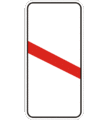
Countdown beacon to railway crossing on left side of road (80 metres to crossing)
-
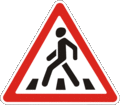
Pedestrian crossing ahead
-
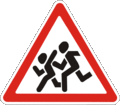
Watch for children
-

Watch for cyclists
-

Watch for farm animals
-

Watch for wild animals
-

Roadworks
-
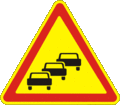
Traffic queues likely
-
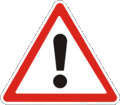
Attention: Other Dangers! (will have an additional plate describing the danger)
-

End of paved road surface
Priority
Priority signs regulate the movement of vehicles in an orderly fashion. The priority road sign tells drives that they have priority at all intersections ahead on the road until the end sign. The traffic bottleneck signs are used where the road is too narrow to permit vehicles to pass side-by-side, but rather must alternate.
-
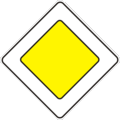
Priority road
-
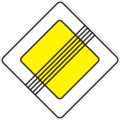
End of priority road
-
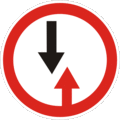
Give way to vehicles coming from the opposite direction
-

Priority over vehicles in opposite direction
Prohibitory
Prohibitory signs regulate the use of the road based on movement, classes of vehicles, or other restrictions.
-
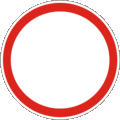
Road closed to all vehicles and persons
-

No motor vehicles
-

No trucks/heavy goods vehicles
-
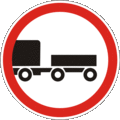
No vehicles pulling trailers
-

No farm vehicles/equipment
-

No motorcycles
-

No mopeds
-
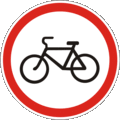
No bicycles
-

No pedestrians
-
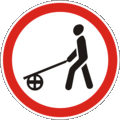
No pedestrians with handcarts
-

No horse-drawn carts
-
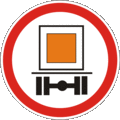
No vehicles carrying dangerous goods
-

No vehicles carrying explosives
-

No vehicles carrying goods that may pollute the water
-

No vehicles over 7 tonnes
-

No vehicles over 5 tonnes per axle
-
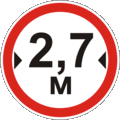
No vehicles wider than 2.7 metres
-
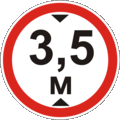
No vehicles higher than 3.5 metres
-

No vehicles longer than 10 metres
-
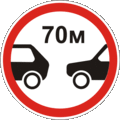
Drivers must maintain a distance of at least 70 metres
-

No entry
-

No right turn
-

No left turn
-
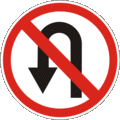
No U-turn
-

No Overtaking
-
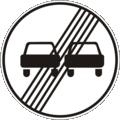
End overtaking prohibition
-

No overtaking by trucks/heavy goods vehicles
-

End overtaking prohibition for trucks/heavy goods vehicles
-
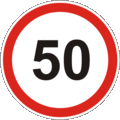
50 km/h speed limit
-

End 50 km/h speed limit (limit reverts to default for road class)
-

50 km/h speed limit zone
-

End 50 km/h speed limit zone (limit reverts to default for road class)
-

No sounding your horn or excessive noise
-

No stopping or parking
-
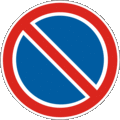
No parking
-
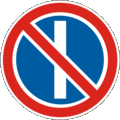
No parking on odd-numbered days
-
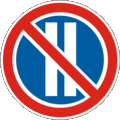
No parking on even-numbered days
-

No parking zone
-

End no parking zone
-

Stop at customs required
-

Stop for other road control
-

End all previously signed restrictions or prohibitions
-
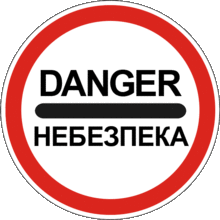
Stop for dangers, including traffic accidents, natural disasters or other road obstructions
Mandatory
Mandatory signs instruct drivers on actions they must take or obey, or may mark types of vehicles permitted to use the road.
-

Proceed straight ahead only
-
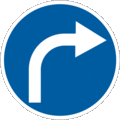
Turn right only
-
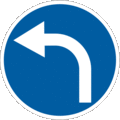
Turn left only
-
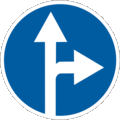
Proceed straight or turn right
-

Proceed straight or turn left
-

Turn left or right (no straight ahead)
-
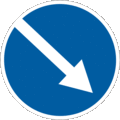
Keep right
-
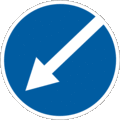
Keep left
-

Pass either side
-
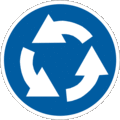
Roundabout
-
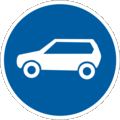
Motor vehicles only
-

Bicycles only
-
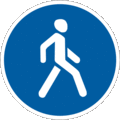
Pedestrians only
-
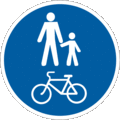
Bicyclists and pedestrians only
-

Equestrians only
-

50 km/h minimum speed limit
-
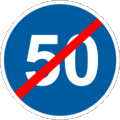
End 50 km/h minimum speed limit
-

Vehicles carrying dangerous goods may proceed straight ahead only
-

Vehicles carrying dangerous goods may turn right only
-

Vehicles carrying dangerous goods may turn left only
Information
Information signs describe conditions of the road and area that do not require a danger warning, mandatory instruction or prohibition.
-

Dual-carriageway motorway begins
-

Dual-carriageway motorway ends
-

Motorway begins
-

Motorway ends
-
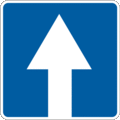
Forward one-way street
-

Forward one-way street ends
-

Rightward one-way street
-

Leftward one-way street
-
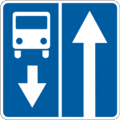
Forward one-way street with reverse lane for buses
-
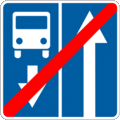
Forward one-way street with reverse lane for buses ends
-
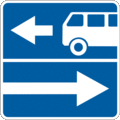
Rightward one-way street with reverse lane for buses
-
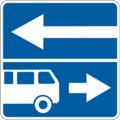
Leftward one-way street with reverse lane for buses
-
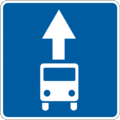
Forward one-way street for buses
-

Forward one-way street for buses ends
-

Two-way street
-

Two-way street ends
-
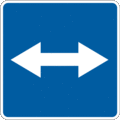
Two-way street bisecting one-way street
-

Lane movement permitted
-

Lane movement permitted
-

Lane movement permitted
-

Lane movement permitted
-

Lane movement permitted with vehicle class restriction
-
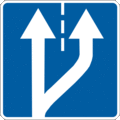
Lane movement permitted
-

Lane movement permitted with minimum speed limit for one lane
-
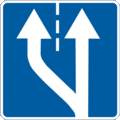
Lane movement permitted
-

Lane movement permitted
-

Lane movement permitted
-

Lane movement permitted
-
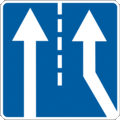
Lane movement permitted
-

Lane closed, proceed into opposing lane
-

Do not enter opposing lane, return to your lane
-

Emergency escape lane for runaway vehicles
-
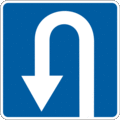
U-turn permitted
-
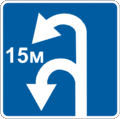
U-turn and left turn permitted
-

Trucks/heavy goods vehicles proceed forward
-

Trucks/heavy goods vehicles proceed right
-

Trucks/heavy goods vehicles proceed left
-

Dead-end street
-
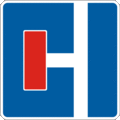
Dead-end street ahead on left
-

Dead-end street ahead on right
-

50 km/h advisory speed
-

Shared living street zone
-

Shared living street zone ends
-

Pedestrians zone
-
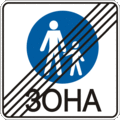
Pedestrians zone ends
-

Pedestrian crossing (placed on right side of road)
-

Pedestrian crossing (placed on left side of road)
-

Stairway down
-
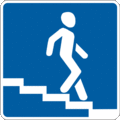
Stairway down
-

Stairway up
-

Stairway up
-

Parking
-

Parking zone
-

Parking zone ends
-

Bus stop (may include schedules and times)
-

Bus stop (alternative)
-

Tram stop (may include schedules and times)
-

Tram stop (alternative)
-

Trolleybus stop (may include schedules and times)
-

Trolleybus stop (alternative)
-

Taxi Stop/Stand/Rank
-

Community begins
-

Community ends
-

Village begins
-

Village ends
-
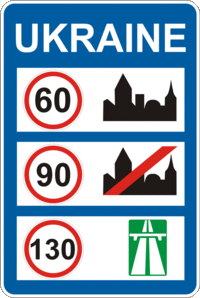
National speed limits (used at border crossings with other countries)
-

Other road restrictions (such as for a mountainous road ahead)
-
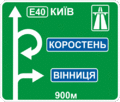
Route guide sign with destinations
-

Route guide sign with destinations
-

Route guide sign with destinations
-

Route guide sign with destinations
-

Route guide sign with destinations
-

Route guide sign with destinations
-
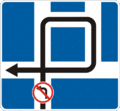
Alternative route to meet your destination where left turn is prohibited
-

Alternative route for closed road
-

Detour route marker
-

Detour route marker
-

Detour route marker
-

Street name sign
-

River name sign
-

Destinations sign with distances
-

Road distance interval marker
-

Road route number sign
-

Road route number sign with arrow to route
-

Road route number sign with arrow to route
-

Stop (used where a regular stop sign is not needed, such as unprotected railway crossings)
-

Built-up area begins
-

Built-up area ends
-

New road signage ahead
-

Airport
-

Train station
-

Bus station
-

Church (may include name or religious denomination)
-

Factory
-

Traffic cameras area
Guide
Guide signs mark the way to road services that may be required by the driver. They may include arrows, distances to, or names of the service.
-

First point of medical care
-

Hospital
-

Emergency phone
-

Emergency fire extinguisher
-

Mechanic
-

Car wash
-

Full-service petrol station
-

Filling-only petrol station
-

Petrol station with mixed services
-

Pay telephone
-

Information booth
-

Traffic police
-

Public washrooms
-

Water
-

Restaurant
-

Refreshments
-

Picnic area
-

Hotel
-

Tourist booth
-

Campgrounds
-

Caravan parking
-

Campgrounds with caravan parking
-

Holiday home/rent house
-

Trail
-

Beaches or public pools
-

National historic/cultural/tourist site
Additional Plates
Additional plates provide extra information about the sign above it.
-

Above sign effective in 300 metres
-

Stop ahead in 250 metres (placed below the Give Way sign to warn of a stop sign ahead)
-

Above danger 300 metres to the left
-

Above danger 100 metres to the right
-

Above danger sign effective for 300 metres
-
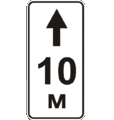
Above prohibition sign effective in 10 metres
-

Above prohibition sign ends
-

Above prohibition sign effective in both directions
-

Above prohibition sign effective for 30 metres to the right
-

Above prohibition sign effective for 30 metres to the left
-

Above sign warning of object on the right
-

Above sign warning of object on the left
-

Above sign warning of object on both sides of road
-

Above sign effective during Saturdays, Sundays and public holidays
-

Above sign effective during working days
-

Above sign effective during weekdays
-

Above sign effective during times
-

Above sign effective during Saturdays, Sundays and public holidays during times
-

Above sign effective during working days during times
-

Above sign effective during weekdays during times
-

Above sign applies to trucks/heavy goods vehicles
-

Above sign applies to vehicles pulling trailers
-

Above sign applies to motor vehicles
-

Above sign applies to buses
-

Above sign applies to farm vehicles/equipment
-

Above sign applies to motorcycles
-

Above sign applies to bicyclists
-

Above sign applies to vehicles carrying dangerous goods
-

How to park
-

How to park
-

How to park
-

How to park
-

How to park
-

No idling during parking
-

Diagram of road priority
-

Above sign applies to this lane only
-

Number of curves in road
-

Approach to ferry
-

Above sign applied during winter conditions
-

Above sign applies during bad weather
-

Toll/payment required
-

Dock or observation well
-

Blind pedestrians may be crossing
-

Disabled parking
-

Above sign does not apply to disabled persons
-

Maximum length for parking
-

Above sign enters force on date
-

Other Danger: accident area
-

Other Danger: accident area
-

Other Danger: accident area
-

Other Danger: accident area
-

Other Danger: this section of road passes near ski slopes or trails, or other winter sports areas
See also
- Comparison of European traffic laws
- Comparison of European road signs
- Traffic sign
- Vienna Convention on Road Signs and Signals
